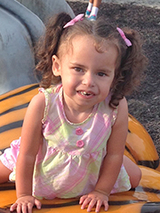Tetralogy of Fallot (TOF): Alissa’s Story
Tetralogy of Fallot (TOF): Alissa’s Story
When Alissa was just 8 days old, she underwent heart surgery to treat tetralogy of Fallot (TOF), a congenital heart defect. Now 3, her mom describes her as “very sweet and loving — but also a very strong and spirited little girl.”

When Megan was 13 weeks into her pregnancy, a scan revealed that the baby she was carrying appeared to have omphalocele, a condition where the baby’s abdominal cavity doesn’t form properly. Her doctor suggested additional testing to confirm the diagnosis and look for any underlying genetic problems.
Megan and her husband, Joe, made an appointment to have their 20-week ultrasound at the Richard D. Wood Jr. Center for Fetal Diagnosis and Treatment at Children’s Hospital of Philadelphia (CHOP).
Unexpected cardiac complications
But before they got to that appointment, a 17-week ultrasound at the facility near their home in New Jersey showed a different problem: The baby didn’t appear to have omphalocele, but instead, abnormalities were noted in her heart, and the baby appeared to have tetralogy of Fallot (TOF).
More About TOF
Tetralogy of Fallot (TOF) is a congenital heart defect that refers to a combination of heart defects, including a ventricular septal defect, a hole between the lower chambers of the heart; overriding aorta, when the aorta is on top of both ventricles instead of just the left ventricle as in a normal heart; pulmonary stenosis, a narrowing of the pulmonary valve that affects blood flow from the heart to the lungs; and hypertrophy, when the right ventricle becomes thicker and more muscular than normal as a result of working harder to pump blood through the narrow pulmonary valve.
Around the same time, results of blood tests came back, showing that the fetus had chromosome 22q11.2 deletion, a genetic condition which can be associated with a range of health problems, including heart malformations.
Megan and Joe called CHOP and explained the new information. They were advised to come in for the 20-week ultrasound as scheduled, but a different set of medical specialists would now be prepared to meet with them.
Coordinated cardiac care
At their first visit to CHOP, Megan and Joe were immediately impressed with the experts they met and their coordinated approach to care. After a fetal body MRI to check for omphalocele (which was not found) and an echocardiogram, they consulted with cardiologist Michele Cohen, DO, Thomas Spray, MD, Chief of the Division of Cardiothoracic Surgery, and Elaine Zackai, MD, Director of CHOP’s Clinical Genetics Center.
“Everyone was amazing,” says Megan.
“By the end of that day, I felt more at peace. We were with people who understood our baby’s condition.”
Megan made plans to deliver her child at CHOP in the Garbose Family Special Delivery Unit, the world’s first birth facility in a pediatric hospital specifically designed for mothers carrying babies with known birth defects.
For the remainder of her pregnancy, Megan went to CHOP for monthly ultrasounds to monitor her baby’s heart.
“Those appointments helped us get through that time. They kept us connected with the medical team and reminded us that they were prepared to handle this. It helped us relax a little,” says Megan.
Alissa was born in early December, and immediately taken to the Cardiac Intensive Care Unit (CICU) while Megan recovered nearby.
Heart surgery at 8 days old
When she was 8 days old, Alissa had surgery to repair her heart, performed by Dr. Spray. He patched the hole and widened the pulmonary valve or artery.
Once Alissa had bounced back from the surgery, Megan and Joe noticed that her color had improved. For her first week she had had a dark, purplish complexion. Now she was lighter and pinker.
Alissa stayed at CHOP for 12 days after the surgery. When she was discharged, she still required some special care, including feedings every two to three hours, day and night, through a nasogastric (NG) feeding tube. But otherwise, she was doing well.
Alissa has required some additional interventions since then. A catheterization procedure was used to place a stent in her pulmonary artery for pulmonary artery stenosis. Another procedure was done to correct a tethered spinal cord. She remained on an NG tube for her first 18 months and has had the stent replaced once.
Alissa today

Since her complications as a baby, Alissa has been doing well. Now 3, Megan describes Alissa as “very sweet and loving, but also a very strong and spirited little girl.” Alissa has received physical, occupational and speech therapy since she was a baby, but the only delay now is with her speech. She has a slightly malformed palate, which could be hindering her speech development, and may have that corrected with surgery eventually.
Alissa is enrolled in CHOP’s Cardiac Kids Developmental Follow-up Program. As a whole, children with complex congenital heart disease (CHD) have a higher likelihood of experiencing problems related to neurodevelopmental issues compared to children without CHD.
The Cardiac Kids Developmental Follow-up Program was created to provide coordinated care for these children. The program provides screening, evaluation and coordinated care from a multidisciplinary team of experts that includes cardiologists, pediatricians, nurses, psychologists, social workers, and physical, speech and occupational therapists.
The program helped the family arrange for early intervention services at home when Alissa was younger, and helped them enroll her in the special preschool she now attends. Dr. Cohen, who Megan and Joe met at their initial visit to CHOP before Alissa was born, continues to be Alissa’s cardiologist.
“I can’t say enough good things about everyone we’ve encountered at CHOP,” says Megan.
“They have always been so caring not just to Alissa, but to our whole family, by offering so much support and expertise. They’ve given us hope!”